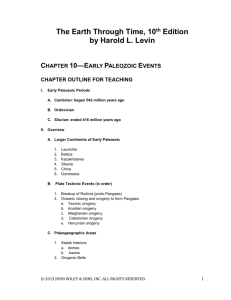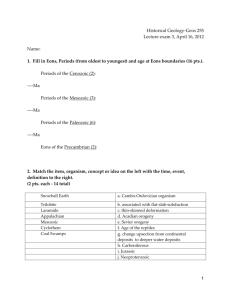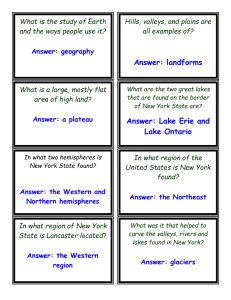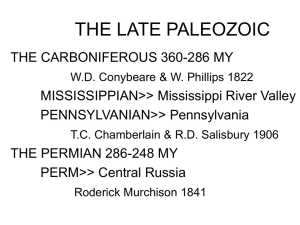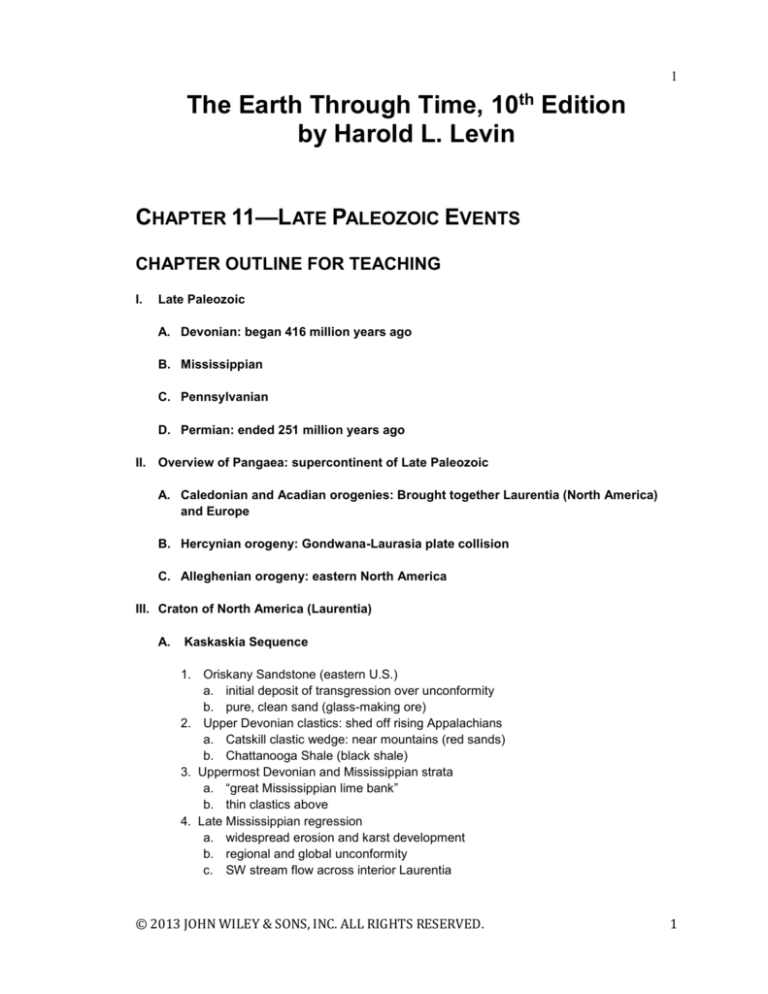
1
The Earth Through Time, 10th Edition
by Harold L. Levin
CHAPTER 11—LATE PALEOZOIC EVENTS
CHAPTER OUTLINE FOR TEACHING
I.
Late Paleozoic
A. Devonian: began 416 million years ago
B. Mississippian
C. Pennsylvanian
D. Permian: ended 251 million years ago
II. Overview of Pangaea: supercontinent of Late Paleozoic
A. Caledonian and Acadian orogenies: Brought together Laurentia (North America)
and Europe
B. Hercynian orogeny: Gondwana-Laurasia plate collision
C. Alleghenian orogeny: eastern North America
III. Craton of North America (Laurentia)
A.
Kaskaskia Sequence
1. Oriskany Sandstone (eastern U.S.)
a. initial deposit of transgression over unconformity
b. pure, clean sand (glass-making ore)
2. Upper Devonian clastics: shed off rising Appalachians
a. Catskill clastic wedge: near mountains (red sands)
b. Chattanooga Shale (black shale)
3. Uppermost Devonian and Mississippian strata
a. “great Mississippian lime bank”
b. thin clastics above
4. Late Mississippian regression
a. widespread erosion and karst development
b. regional and global unconformity
c. SW stream flow across interior Laurentia
© 2013 JOHN WILEY & SONS, INC. ALL RIGHTS RESERVED.
1
2
B. Absaroka Sequence
1. Deposited on top of regional unconformity
a. thicker near the eastern highlands
b. change in rock type from clastics (east) to carbonates (west)
2. Unique cyclic sediments (Pennsylvanian): “cyclothems” consist of 10
beds with minor disconformities at top and bottom of cyclothem
a. shale (marine): youngest layer
b. limestone (marine)
c. shale (marine)
d. limestone (marine)
e. shale (near-shore)
f. coal (swamp)
g. gray underclay (lake)
h. freshwater limestone (lake)
i. sand shale/siltstone (lake)
j. sandstone (river deposits): oldest layer
3. Origin of cyclothems: repeating sea-level rise and fall due to glacial eustasy
a. glacial eustasy: Gondwanaland at South Pole with ice cap
b. regional subsidence: alternative hypothesis
IV. Instability in southwestern continental interior
A. New Mountains in the West
1. Colorado Mountains (includes Front Range-Pedernal, Uncompahgre, and ZuniDefiance uplifts)
2. Oklahoma Mountains (Amarillo, Washita, and Arbuckle uplifts)
B. Paradox and other nearby basins:
1. Filled with sediment from the Uncompahgre Mountains
a. Paradox Basin initially open to the sea
b. Paradox became blocked and evaporites formed
c. Paradox now important petroleum reservoir
2. All became restricted in their connection to Permian seas
C. Permian Basin (western Texas)
1. Exposed in the Guadalupe Mountains
2. Over 14,000 feet of lagoon, reef, and open basin carbonate sediments
3. Estimated water depth: 500 meters
© 2013 JOHN WILEY & SONS, INC. ALL RIGHTS RESERVED.
2
3
V. Eastern Margin of North America (Laurentia)
A. Acadian orogeny
1. Collision with Baltica
2. Collision with Avalon terrane (microcontinent)
B. Alleghenian orogeny
1. Collision with northwestern Africa that affected southern Appalachians
2. Effects felt in western U.S. such as raising Colorado and Oklahoma
C. Acadian orogeny: built northern Appalachian Mountains
1. Catskill clastic wedge (Devonian)
a. sandstone/shale facies document orogenic pulses
b. deposited in a tropical climate; lots of vegetation
c. major new source for oil and gas, especially in the Marcellus Shale where there
is new horizontal drilling and fracturing activity
2. Catskill equivalent in Europe: Old Red Sandstone of the Caledonian orogeny
D. Post-Acadian Events
1. Pocono facies: younger mimic of Catskill
a. black shale (anoxic sea): west
b. shale
c. sandstone (shoreline)
d. conglomerate (mountain front): east
2. Coal-bearing facies: channel sandstones cut in gray shales with coals
E. Alleghenian Orogeny
1. Northern Gondwanaland collides with Laurussia (N. Africa-eastern U.S.
and S. America-Gulf Coast)
2. Builds southern Appalachians and Ouachita Mountains
3. Result of “thin-skinned” tectonics
4. Characteristic orogenic structures
a. Valley and Ridge Province and the Appalachian Plateau
b. vast metamorphic Blue Ridge and Piedmont regions
5. Characteristic post-orogenic sediments
a. red sandstone and shale (non-marine)
b. geometry like Queenston and Catskill clastic wedges
c. examples: Dunkard and Monongahela Series of eastern U.S. (PennsylvanianPermian)
© 2013 JOHN WILEY & SONS, INC. ALL RIGHTS RESERVED.
3
4
F. Ouachita Deformation
1. Pre-collision sediments (Early Devonian-Late Mississippian)
a. carbonates on shelves of Laurentia and Gondwanaland
b. bedded chert in basin center (novaculite)
2. Closing-phase sediments (Late Mississippian-Late Pennsylvanian)
a. carbonate shelves die
b. 8000 m of graywacke in basin
3. Collision characteristics
a. northward thrust faults
b. intensive folding
4. Permian = stable time after abrupt end to orogenesis
5. Orogenic mountains today
a. Ouachita Mountains (AR, OK)
b. Marathon Mountains (TX)
c. subsurface folded structures (U.S. Gulf Coast)
VI. Western Orogeny: Cordilleran
A. Antler Orogeny (Late Devonian-Pennsylvanian)
1.
2.
3.
4.
Island-arc collision with west coast of Laurentia
Vast thrust faulting and folding of back-arc sediments: NV, ID
Thick clastic wedges in basins: UT, WY, CA
Volcanism (Mississippian-Permian): CA, NV, ID, MT, BC
B. Later Orogenesis: due to collision with second island arc (Permian-Early
Triassic)
1. Cassier (British Columbia)
2. Sonoma (southwestern U.S.)
C. Shelf-area East of Antler Highlands
1. Quiet shallow sea, lowlands
2. Deposition of Grand Canyon area stratigraphy of Permian age: stability
and transgression
a. Kaibab Limestone (shallow marine)
b. Coconino and DeChelly sandstones (eolian sand dunes)
c. Phosphoria Formation: phosphatic shales and limestones (basinal sediments)
© 2013 JOHN WILEY & SONS, INC. ALL RIGHTS RESERVED.
4
5
VII. Northern Europe
A. “Old Red Continent”: sedimentation from orogenic clastic wedges
B. Uralian Sea
1. Eastern side of the continent
2. Closure produced the Ural Mountains
C. Hercynian orogeny
1. Structure: intensive folding, thrust faulting, granitic intrusions, volcanism
2. Clastic Wedge: heavily vegetated thus forming “coal measures” of Europe
VIII.
Gondwanaland of Late Paleozoic
A. Movement: across South Pole to near equator where it collided with Laurussia
(Hercynian and Alleghenian orogenies)
B. Other Marginal Orogenies
1. Andean (with South America)
2. Tasmanian (with eastern Australia)
C. Vast Glaciers of Pennsylvanian-Permian Polar Cap
1. Great tillite deposits of S. America, S. Africa, Antarctica, and India
2. Record of 4 glacial advances (330-250 million years ago)
3. Two centers of ice accumulation
a. southwest Africa
b. eastern Antarctica
4. Interglacial stages = cool, damp climates
a. thick coals produced
b. Glossopteris flora flourished
D. Post-Glacial Continent
1. Vast non-marine red beds (sandstone and shale)
2. Ancestral mammals developed on continent
IX. Climate of Late Paleozoic
A. Zonation: paralleled lines of latitude
B. Warm to Hot: within 30o of equator
C. Reduced CO2 in Atmosphere: toward end of Paleozoic, brought cooling and
then Late Paleozoic ice age
© 2013 JOHN WILEY & SONS, INC. ALL RIGHTS RESERVED.
5
6
X. Mineral Products
A. Fossil Fuels: coal, oil, gas
1. Coal: present in all post-Devonian rocks
a. Appalachian basin (eastern U.S.)
b. Illinois basin (IL, MO)
c. European basins
d. Permian coals: China, Russia, India, S. Africa, Australia
2. Oil and Gas
a. Devonian reefs of Williston Basin (Alberta, MT, SD)
b. Appalachian basin (PA, WV)
c. Mississippian-Pennsylvanian basins of mid-continent U.S. and
Rocky Mountains
d. Permian basins and reefs (TX)
e. Late Paleozoic basins (North Sea, Europe)
B. Sedimentary Deposits
1. Late Paleozoic Na and K salts
2. Late Permian phosphates
C. Metallic Ores (ores that accompany volcanism)
1. Hercynian-Alleghenian ores: Sn, Cu, Ag, Au, An, Pb, Pt
2. Uralian ores
3. Asian orogenic ores: China, Burma, Japan, Malaya
Answers to Discussion Questions
1. The southern Appalachians (Alleghenian orogeny) and the Ouachita Mountains were built
during the latter part of Late Paleozoic when Gondwanaland and Laurussia were assembled
into Pangaea. This was mainly the result of Gondwanaland’s northern motion causing the
two continents to join near the Late Paleozoic equator.
2. The Alleghenian and Hercynian orogenies occurred at about the same time because of the
convergence of plates that were assembling Pangaea.
3. A displaced terrain will have sharp boundary discontinuities and consist of rock types and
fossil contents very unlike surrounding rocks. The terrain will likely be highly deformed,
especially at the margins. The terrain will likely be situated in a tectonic (orogenic) zone or
belt. An island-arc terrain will be composed mainly of volcanics; a micro-continental terrain
will have a variety of rock types, including sedimentary.
© 2013 JOHN WILEY & SONS, INC. ALL RIGHTS RESERVED.
6
7
4. Upper Paleozoic rocks are easily divided into two great cratonic sequences because there
is a widespread, distinctive erosional surface (disconformity) between Upper Mississippian
and Lower Pennsylvanian strata across much of North America. The lower sequence is
Kaskaskia, spanning most of Devonian and Mississippian. The upper sequence, Absaroka,
spans Pennsylvanian and Permian, and extends into Lower Jurassic.
5. The Old Red Continent was a Middle Devonian feature named for the Old Red Sandstone, a
unit cropping out across Europe south of the Caledonian Mountains. The Old Red Sandstone
is composed mainly of sandstone red beds.
6. The Old Red Continent and its mirror-image equivalent across the mountains, the Catskill
clastic wedge, are so similar that early geologists who had seen both were very impressed.
7. Southern hemisphere (Gondwanaland) glaciation during Late Paleozoic is documented by
extensive layers of tillite, scour marks left in bedrock by glaciers over parts of South America,
south Africa, Antarctica, and India, evidence of glacial-interglacial deposition, and patterns of
ice advance over vast areas.
8. The association of red sandstone, salt, and gypsum suggests oxidizing conditions in a dry,
arid terrestrial area. Such conditions existed during Permian, after regression of the sea from
Baltics and interior Gondwanaland.
9. A cyclothem is a repetitive alternation of marine and non-marine strata recording a single
cycle of minor rise and full of sea level. Eustatic conditions are best accounted for by
periodic changes in water volume due to glacial ice buildup and melting. Other water-level
changes might be due to inflation and deflation of mid-ocean ridges. Tectonic conditions
might include periodic elevation and relation of crustal segments due to stresses on plates.
10. The Chattanooga Shale was deposited in an anoxic marine environment. It is difficult to
imagine how a vast shallow epicontinental sea could be the site for such deposition. In order
to account for the anoxia, the historical geologist must hypothesize vast overproduction of
plankton to seriously deplete the oxygen level in the sea water. As this does not occur to
such a degree in the modern ocean, an actualistic analogue for the Chattanooga sea does
not exist.
11. The South Pole was located in the same place as today but at that time the southern part of
Pangaea covered the area. This has been determined by using paleomagnetic data and
inferences from the rock and fossil record as to latitude. Further, analysis of the distribution of
glacial sediments and ice-formed striations shows the location of glacial centers near the
pole. Coral distribution would be confined to a belt within ± 30 o latitude of the equator, thus
the paleogeographic arrangement could be checked for precision regarding the equatorial
realm.
12. Upper Paleozoic rocks yield important metallic resources including: tin, zinc and lead, and
gold. These rocks yield important non-metallic resources including: coal, oil and gas, and
phosphates.
13. Pennsylvanian algal bioherms of the Paradox basin contain oil and gas because of their
porosity and setting near the margin of the basin where hydrocarbons have been generated.
© 2013 JOHN WILEY & SONS, INC. ALL RIGHTS RESERVED.
7
8
14. d
15. c
16. e
Chapter Activities
Student activities for in-depth learning.
1. Using the resources on the Catskill clastic wedge that is posted on the web at
http://csmres.jmu.edu/geollab/vageol/vahist/catskilenv.html, review and brief describe the
depositional environments of the Catskill clastic wedge and its same-age (equivalent) sediments.
Make a sketch of the regional environments, both in map view and in cross-section based on
information from this web page (and/or similar web pages).
2. Take a look at the page on the Middle and Late Devonian “Old Red Continent” (ORC) at
http://csmres.jmu.edu/geollab/vageol/vahist/oldredcont.html. How was the ORC formed? Make a
sketch and/or describe in writing the modern continents that made up parts of the “ORC.” Where
was the equator at this time and what were the prevailing winds like at this time?
© 2013 JOHN WILEY & SONS, INC. ALL RIGHTS RESERVED.
8




